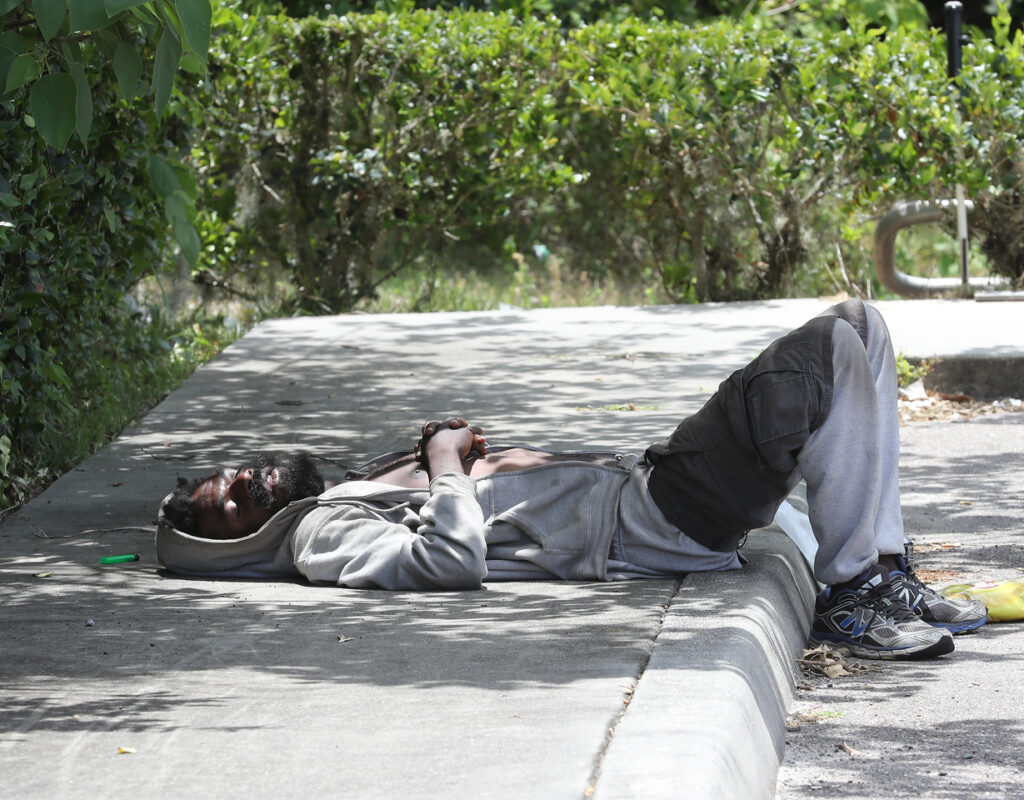Kicking the homeless (problem) down the road

An unidentified homeless man sleeps on sidewalk at the Chevron station on West Silver Spring Boulevard near I-75 in Ocala, Fla. on Wednesday, May 5, 2021. [Bruce Ackerman/Ocala Gazette] 2021.
Before you began reading this column this morning, you probably rolled out of your warm bed, took a steamy shower and enjoyed a cup of coffee or tea. You will go to work, take the kids to their activities and then come home tonight and crawl in between your crisp sheets to sleep.

An unidentified homeless man sleeps on sidewalk at the Chevron station on West Silver Spring Boulevard near I-75 in Ocala. [Bruce Ackerman/Ocala Gazette] 2021.
For more than 200 homeless people in the city of Ocala, the ability to sleep safely and securely is not guaranteed. Many of them huddle under trees, behind hedges or in the dark doorways of area businesses hoping to avoid detection by police and other street people. Some found refuge inside the gates of Interfaith Emergency Services, protected by armed security and able to use restrooms, get meals and sleep soundly, without fear of being arrested or attacked.
Karla Grimsley, CEO of Interfaith, says they have roughly 100 people on their campus daily. Between October 2020 and April 2021, the staff at Interfaith culled 122 people from the streets or the woods and offered them refuge and a measure of stability. Grimsley saw the need for this shelter after homeless camps were shut down in January and people began congregating outside Interfaith’s gates.
Sadly, on May 18, the Ocala City Council nixed an ordinance that would have allowed this emergency shelter to continue operating, saying the shelter violated city zoning rules against sheltering in the open.
Several residents that live near Interfaith spoke out against this ordinance, fearing it would attract more homeless to the area and lead to an increase in crime. Mayor Kent Guinn, who has no vote on Council matters, showed a series of inflammatory photos depicting alleged drug use, violence and squalor among the homeless community. These photos pre-dated the open-air shelter, according to Grimsley.
Despite the passionate pleas of Interfaith clients and homeless advocates, Council voted 3-2 to shut down the open-air shelter.
Archbishop Desmond Tutu said, “There comes a point where we need to stop just pulling people out of the river. We need to go upstream and find out why they’re falling in.”
Yes, this open-air shelter can be seen as just pulling people out of the river. It is a temporary solution to what has become a permanent problem in Marion County: homelessness. But, eliminating this shelter immediately placed 20 homeless people back on the streets to seek shelter in the doorways of area businesses and on the benches of local parks.
It is time for us as a community to go upstream and find out why people are falling in. We need to ask ourselves hard questions to determine what has caused homelessness locally and what can be done to address it. Why are these people becoming homeless or remaining homeless? Can we provide more affordable housing? Are the social services offered to our homeless population readily accessible to them, including those who lack transportation? Would the addition of a day center serve our homeless community and relieve the strain on our healthcare, criminal justice and social services systems?
In a 2019 report by the Public Policy Institute of Marion County titled Homelessness: The Long Way Home, the participants in this study sought to reduce homelessness in Marion County by 60 percent by 2024.
The report offered several key suggestions:
1. Expand outreach to homeless individuals and families to connect them with social services that will move them from homelessness to stability;
2. Establish a day center. Local shelters are “high barrier” shelters and do not allow people to congregate during the day. A day center facility could positively impact loitering and vagrancy activities among the homeless population. This facility would create a central access point to allow the homeless to obtain the services they need;
3. Expand Permanent Supportive Housing in Marion County. This pairs housing with case management and supportive services for the county’s chronically homeless;
4. Shift resources from sheltering and transitional housing to rapid re-housing efforts. Rapid re-housing connects homeless families and individuals with permanent housing through time-limited financial assistance and targeted supportive services.
These suggestions can be put into action and made a reality if the Ocala City Council, Marion County Board of County Commissioners, non-profit organizations and our citizens work together. The “not in my backyard” mentality can no longer be the party line. This issue of homelessness is in all of our backyards, and we must begin to take steps to solve this issue.
Shutting down this temporary open-air shelter does not make this problem go away. Sanctioning this shelter would serve as a temporary fix while Council, Interfaith and other local organizations dedicated to helping the homeless work to develop solutions for solving this crisis.
This is not a “them (the homeless) versus all of us” issue. True to our Southern roots, we are a city that throws open its doors and welcomes everyone. It’s time we open our hearts and collaborate to ensure all of our citizens have the benefit of a warm, secure place to lay their heads at night.
To learn more about Interfaith Emergency Services and how you can contribute to their outreach efforts, visit www.iesmarion.orgwww.iesmarion.org.
Sadie Fitzpatrick uses this space to explore the character and quirks that make Ocala uniquely wonderful and occasionally irksome. Have your own observations about Ocala? Share them with Sadie at sadie@ocalagazette.com.
Have your own observations about Ocala? Share them with Sadie at sadie@ocalagazette.com.





